Photography and society. History of photography in Spain
|
Photography and society from its
origin to the 21st century.
History of photography in Spain.
From 13 February to 15 April 2007.
Estudi General Room, Thesaurus Room, Martínez
Guerricabeitia Room. La Nau
From
Tuesday to Saturday, from 10 to 13.30 and from 16 to 20 h.
Sunday, from 10 to 14 h.
|
|
|
|
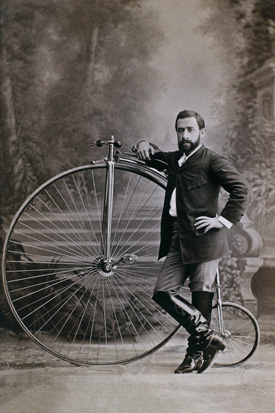 |
|
|
|
«History
of photography in Spain. Photography and society from
its origin to the 21st century» shows the
evolution of photography in Spain since the introduction
of the daguerreotype in 1839 until the border between
the 20th and 21st centuries. In
addition, the exhibition becomes an amazing graphic
mirror of Spanish life as well as of the political,
social, cultural, industrial and urban intra-history of the country. Through over 400 photographs from more than a hundred
Spanish and foreign archives and collections, we
come closer to Spain's past reality and the profound
changes it has undergone, especially in the years after
the democratic transition. The images depict the first
shaky trains and diligences; portraits of bullfighters,
politicians, writers, artists and famous soldiers;
relevant events, from the Carlist Wars to the 1868
Revolution or the unfortunate campaign in Morocco; the
Civil War and the long struggle for democracy;
industrial and planning transformations; a gallery of
popular characters like witch doctors, swindlers, mule
drivers, spice sellers, peddlers, and the whole nomadic
fauna of the time, including the travelling
photographer. |
|
|
|
 |
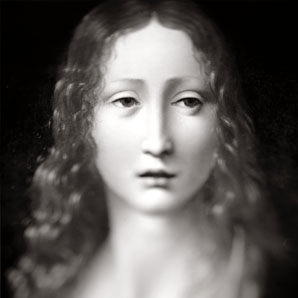 |
|
|
|
Each of the three exhibition rooms will
cover a period in the history of photography Estudi
General, ‘From the onset of photography to the late 19th
century’; Thesaurus, ‘Photography and society from the
beginning of the 20th century to the end of
the Civil War’; and Martínez Guerricabeitia,
‘Photography and society from the start of Franquism to
democratic consolidation’.
The exhibition has been organised by
Universitat de València and Lunwerg Editores, with the
support of the Ministry of Culture. |
|
|
|
 |
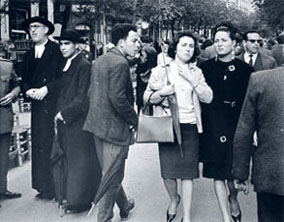 |
|
|
|
Part 1: ‘From the onset of photography to the late 19th
century’
Estudi General Room
Consisting of a hundred images, the first part shows the
evolution of photography from the daguerreotype and the
collotype to the technical development of the collodion,
albumin and gelatin bromide, which made it possible for
travel photography, portraits, and graphic journalism to
appear. Photographs were selected for their technical
and artistic quality and their worth as people’s
testimonies, habits, trades, historic anniversaries and
ways of living and dying in 19th century Spain. We can
see the way our villages and towns looked, the
diligences and the first trains; portraits of
celebrities (bullfighters like Cúchares and Frascuelo,
writers like Bécquer or Carolina Coronado, politicians
like Castelar or Cánovas del Castillo, soldiers like
Narváez and Espartero, actors like Julián Romea);
historic events, like the Carlist Wars, the cantonal
uprising of Cartagena, the 1868 revolution or the
campaigns in Morocco; industrial and planning
transformations; a gallery of popular characters like
witch doctors, swindlers, spice sellers, peddlers, and a
the whole nomadic fauna of the century, including the
photographer himself. |
|
|
|
 |
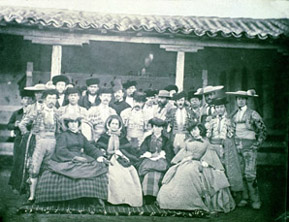 |
|
|
|
Given their technical and documentary importance, the
photographs of bridges, railways, lighthouses, viaducts
and canals being built are particularly outstanding. The
photographs by Charles Clifford and Jean Laurent are
praiseworthy. They are both emblematic photographers of
19th century photography. But there are also foreign
photographers who did not stay in Spain but left us
excellent images, like R. P. Napper, the members of the
Levy Company, W. Atkinson or Paul Nadar, whose works are
almost unknown in Spain. In 1860, members from the first
generation of Spanish photographers settled down in the
country, like José Spreafico, Martínez Sánchez, Martínez
Hebert, Facio, Alonso Martínez, José Rodrigo, Casiano
Alguacil Garzón or Francisco Zagala. Their best works
have been included in the exhibition, for instance the
extraordinary images by Spreafico on the occasion of the
construction of the railway from Cordoba to Málaga in
the last years of the Isabel’s reign or the splendid
photographs taken by Martínez Sánchez. |
|
|
|
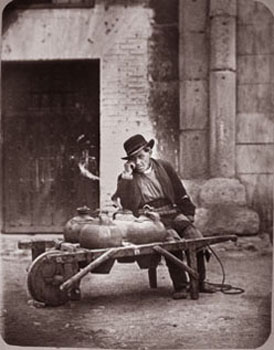 |
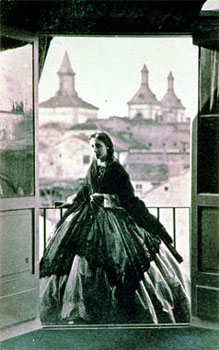 |
|
|
|
Part 2: ‘Photography and society from the beginning of
the 20th century to the end of the Civil War’
Thesaurus Room
The structure of part 2 is determined by the very
history of Spanish photographic movements over those 40
years, from pictorialism to the Avant-gardes, through
photographic portrait art, press photography and popular
photography. An overview that gives us an overall
picture of photography, Spanish life and its most
relevant events, as well as its interrelations with
political, social, and cultural life during an exciting
period that came to an end with the military uprising in
1936 and the Civil War. With more than a hundred
photographs, this section offers a sentimental and
exciting chronicle of those years, when the secular
fight between the old and the new led Spain to one of
the most dramatic civil confrontations in its
unfortunate contemporary history.
Some of the most important photographers of the first
third of the century were portrait photographers. Their
works allow us to get close to this important
photographic speciality and get to know both renowned
figures and anonymous street dwellers. This section
presents works by Káulak, Franzen, Audouard, Alfonso or
Venancio Gombáu. Likewise, at the beginning of the 20th
century, photographic pictorialism appeared in Spain.
Through the so-called noble emulsions, it aimed
to reach the artistic status that painting had. Most of
the photographers in this movement worked in a
handcrafted way, using procedures that are no longer
applied like gum brichromate, charcoal or bromoil. Among
them are Pla Janini, Goicoechea, Antoni Campañà, and
Ortiz-Echagüe. From different approaches and without the
artisticity ambition of the pictorialists, dozens of
modest photographers exhaustively documented the life of
peoples and individuals, like Luis Escobar, Felipe
Manterola, Pacheco, Suárez or the members of the Alfonso
family. Many of them worked as press photographers,
leaving us their testimony of the most relevant events
in the history in Spain, from the campaigns in Morocco
to the Tragic Week of Barcelona, the general strike in
1917 or the Civil War. The eclipse of pictorialism gave
way to movements that marked inter-war photography, like
the New Objectivity or New Vision. Although their
influence in Spain was scarce, their print can be seen
in the works by Nicolás de Lecuona, Català Pic or Josep
Renau, also included among the exhibits.
This is indeed a unique opportunity to see the works of
‘classic’ authors in the history of Spanish photography. |
|
|
|
|
|
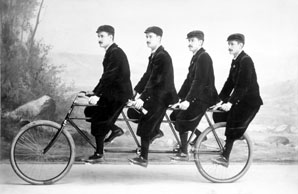 |
 |
|
|
|
Part 3: ‘Photography and society from the start of
Franquism to democratic consolidation’
Martínez Guerricabeitia room
The third part of the exhibition is focused on the
evolution of Spanish photography during the Franco era
and the consolidation of democracy up until the
beginning of the 21st century. Over a hundred
photographs make up a moving testimonial of the
miserable situation of Spain at the time: the black
market, hunger, repression, ration books... Muñoz Molina
writes in the prologue to the catalogue “Here are the
dirty faces, the espadrilles of poverty, the horror of
the uniforms and the shaved heads of prisons, the
fascist salute of the winners, the crucifixes and the
portraits of Franco on the classroom wall, the sinister
darkness and the old miseries of a defeated”. |
|
|
|
 |
|
|
|
But the photographs also show us the slow and hard
evolution of a country fighting to bring back its
dignity and leave behind the devastated territory of
defeat, from the regime’s mild liberalisation and the
appearance of the first resistance movements to the
convulsed and hopeful eve of democracy and the
consolidation of freedom and democratic normality. |
|
|
|
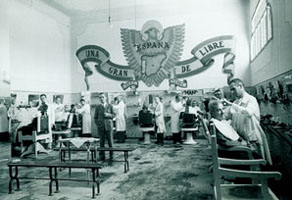 |
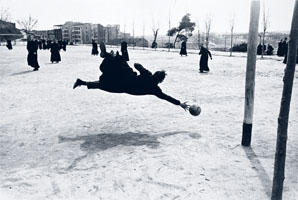 |
|
|
|
The exhibition is an analytical tour around photographic
movements in Franco’s and Post-Franco’s Spain, from the
popular photography of an autarchic Spain to the
currents of the 70s and 80s avant-garde and the digital
revolution, studio portrait photography, the academicist
officialism that stemmed from late pictorialism, press
photography, and the documentary avant-garde of the
1950s. |
|
|
|
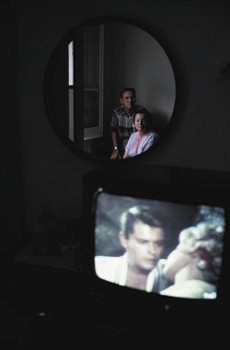 |
|
|
|
This section includes works by the great masters of the
time, Català Roca, Xavier Miserachs, Paco Gómez, Ramón
Masats, Gabriel Cualladó, Pérez Siquier, Leopoldo Pomés,
Paco Ontañón, Carlos Saura, Alberto Schommer or Sanz
Lobato, members of younger generations like Cristina
García Rodero, Koldo Chamorro, Ramón Zabalza, Isabel
Muñoz, Marisa Flórez, Chema Madoz, García Alix, Kim
Manresa, Ricky Dávila, Navia, Miguel Trillo, Xurxo
Lobato, Lobo Altuna, Castro Prieto or Javier Bauluz. |
|
|
|
 |
|
|
|
|